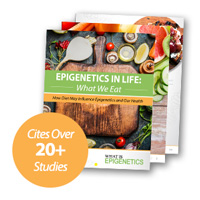
The risk of a person living in an industrialized country developing high blood pressure during their life is over 90% [1]. Left uncontrolled for a long time, high blood pressure together with conditions like obesity, diabetes, and excess lipid (hyperlipidemia) can generate serious illnesses like heart disease, stroke, kidney failure, dementia, and early death [1]. Despite available and effective medicine, most patients with high blood pressure – or hypertension, as it’s known scientifically – cannot heal it.
This is somewhat puzzling, and scientists have proposed several reasons for the phenomenon. One simple explanation is unhealthy lifestyles, including diets high in salt, fat and processed food driving this disease [2]. Why they do this is more complicated, and recent research shows that food can actually affect our epigenetics, and increase – or decrease blood pressure through this mechanism.
One branch of epigenetics focuses on RNA (which we’ve all heard of, thanks to Pfizer’s vaccine). There are many types of RNA, and the one that Pfizer is using is messenger RNA, or mRNA. The fleet-footed messengers of the cell, these are single chains of molecules known as nucleotides strung together.
They relay instructions between a gene and the cell building machinery, telling it which protein to construct. Overseeing this building work is another type of RNA known as microRNAs, or miRNAs. Shorter than mRNAs, each specific miRNA can block its partner mRNA, preventing the protein from forming.
The architects of the cell, miRNAs epigenetically control which proteins are being made at any given moment.
A group of scientists from the University of Toledo examined the link between essential hypertension (high blood pressure with an unknown medical cause), our diet and miRNAs by reviewing past research carried out on the topic [3]. Their conclusion: the impact of our diet on miRNA expression in the gut and liver can stimulate or obstruct high blood pressure development.
Different food groups, such as carbohydrates, proteins and lipids, exert different changes on the type and number of miRNAs in cells. Consequently, different proteins – some of which affect blood pressure – are built.
For example, different proportions of proteins that narrow blood vessels, activate the renin-angiotensin system, and maintain the correct composition of vein and artery walls will modify blood pressure levels. Diets high in specific food groups therefore influence blood pressure levels through epigenetics.
A carbohydrate-rich diet, such as a high-fructose corn syrup diet, decreases the expression of miR-19b and miR-101a. Both these miRNAs act to suppress fat deposits in arteries. When they are expressed less, fat levels in arteries heighten, and blood pressure increases.
The good news is that a high-protein diet seems to protect against developing high blood pressure, based on research so far. No studies have been carried out on the effects of proteins on miRNAs controlling blood pressure, so that remains to be discovered.
However, lipids and fatty acids compounded with a non-active lifestyle can lead to hyperlipidemia-dependent changes in miRNAs expressed, causing blood vessel hyperreactivity and heart remodeling. Specifically, miR-21 is highly expressed where there is lots of lipid, and this miRNA interferes with smooth muscle cell positioning when blood vessels are reshaping.
Of the four types of fatty acids – saturated, monounsaturated, polyunsaturated and trans-fat – only polyunsaturated fatty acids are not associated with high blood pressure. In fact, although levels of miR-14 are usually low due to essential hypertension, rats fed a high-fat diet of polyunsaturated fatty acid omega 6 had their levels restored to normal. This gives rise to the exciting prospect of using polyunsaturated fatty acids to treat high blood pressure activated by hyperlipidemia!
Exploring the role of miRNA in relation to blood pressure has led to detecting another of its potential uses in the clinic. Since obesity is a high-risk factor for essential hypertension, bariatric surgery can be used as a preventative treatment. This reduces obesity, lowering the chance of developing high blood pressure. Interestingly, miRNA levels change after a successful bariatric surgery resulting in weight loss (together with a lower body mass index, lower percentage fat mass, lower blood glucose levels, and lower liver transaminases). Consequently, sampling and measuring a patient’s miRNAs may one day be used to diagnose if a surgery succeeded or not.
We have just begun to glimpse the role of miRNAs relating to food, and the complex, intricate sophistication of these processes. Other types of regulatory RNAs may be strongly involved in the epigenetic control of blood pressure too, and this is an exciting area of further research. The more we fully understand all the molecules playing a part in preventing or promoting the development of high blood pressure, the easier it will be to treat.
References:
- Messerli, F. H., Williams, B. and Ritz, E. (2007) ‘Essential hypertension’, The Lancet, 370(9587), pp. 591-603.
- The Lancet (2007) ‘Hypertension: uncontrolled and conquering the world’, The Lancet, 370(9587), p. 539
- Golonka, R. M. et al. (2021) ‘Impact of Nutritional Epigenetics in Essential Hypertension: Targeting microRNAs in the Gut-Liver Axis’, Curr Hypertens Rep, 23(5).


